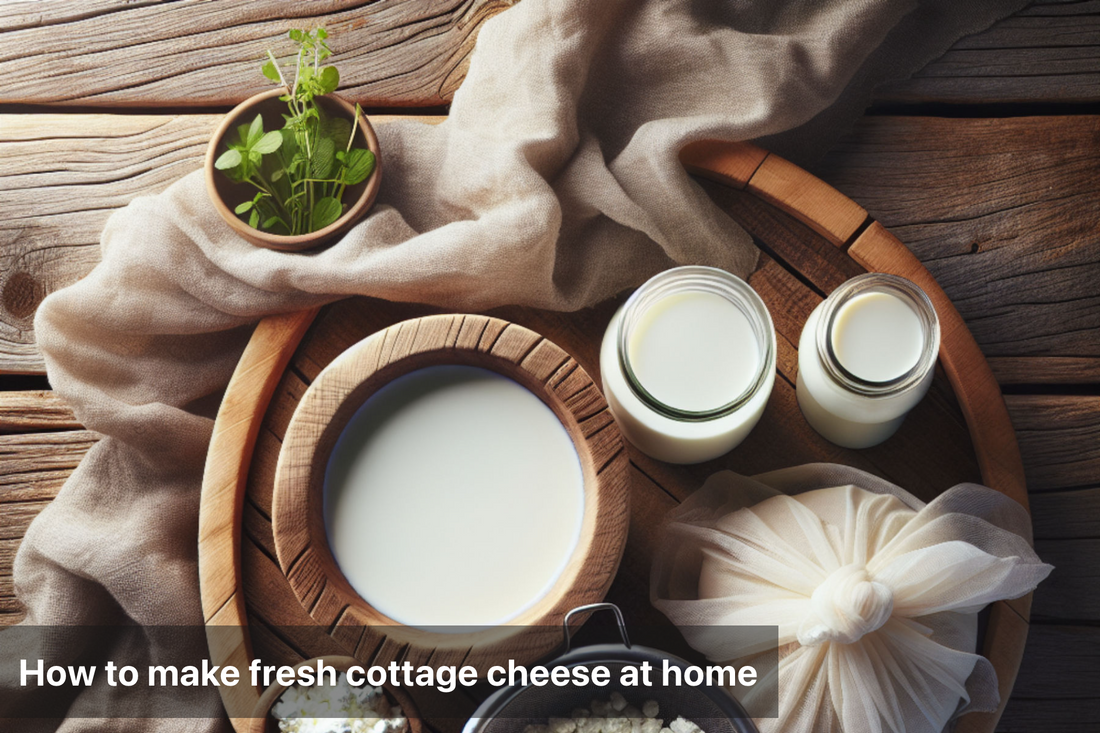
How to make fresh cottage cheese at home
Share
Fresh cottage cheese, or paneer, is a cornerstone of many healthy and vegetarian diets. Soft, mild, and protein-rich, it’s incredibly versatile and used in everything from curries and salads to grilled snacks and desserts. While store-bought options are convenient, making fresh cottage cheese at home offers unmatched purity, flavor, and freshness—plus it's surprisingly easy and requires just two ingredients.
This guide walks you through the foolproof process of making cottage cheese at home, tips for better texture, storage guidelines, and exciting ways to use your homemade paneer creatively in everyday meals.
Why Make Cottage Cheese at Home?
No preservatives or additives
Customizable firmness and texture
Economical and fresh
Better taste and nutrient retention
Control over fat content by choosing the type of milk
Homemade cottage cheese is ideal for people who value clean eating, cook often, or want to enjoy authentic flavor and softness in their recipes.
Ingredients and Tools Required
Ingredients:
1 litre full-fat cow milk (or buffalo milk for firmer paneer)
2–3 tablespoons lemon juice or white vinegar
A pinch of salt (optional)
Tools:
Heavy-bottomed saucepan
Wooden spoon
Cheesecloth or muslin cloth
Strainer or colander
Bowl (for collecting whey)
Step-by-Step Method to Make Cottage Cheese at Home
Step 1: Boil the Milk
Pour 1 litre of milk into a clean, heavy-bottomed pan. Bring to a gentle boil over medium heat, stirring occasionally to avoid scorching. Turn off the heat as soon as it comes to a rolling boil.
Step 2: Curdle the Milk
Add lemon juice or vinegar slowly, 1 tablespoon at a time, while stirring gently. Within 30 seconds to 1 minute, the milk will begin to curdle—white curds will separate from the greenish whey. If it doesn’t curdle fully, add a little more acid and heat for 30 seconds.
Step 3: Strain and Rinse
Place a muslin cloth over a strainer and pour the curdled milk into it. Rinse gently with cold water to remove the acidic flavor and stop further cooking. This also improves the texture.
Step 4: Drain and Shape
Gather the cloth edges and squeeze out excess water gently. Tie and hang it over a sink or tap for 30–40 minutes to drain completely. For a firmer texture, place it under a weighted plate for another 30 minutes.
Step 5: Unwrap and Store
Once set, open the cloth and cut the paneer into cubes or crumble as needed. Use immediately or refrigerate in an airtight container for up to 3 days.
Unique Add-Ins and Variations to Try
1. Herbed Paneer
Add chopped mint, coriander, or oregano to the milk just after curdling for flavored cottage cheese. Great for salads and wraps.
2. Spiced Cottage Cheese
Mix cumin seeds, chili flakes, or black pepper into the curds before pressing. Adds a subtle kick, perfect for snacking.
3. Low-Fat Version
Use low-fat or skimmed milk. The yield is lower, and the texture is less rich, but it’s ideal for calorie-conscious meals.
4. Sweet Paneer Base
Skip salt and add cardamom or saffron strands during the boil. This base works well in Indian sweets like rasgulla or sandesh.
Comparing Homemade and Store-Bought Paneer
Feature |
Homemade Paneer |
Store-Bought Paneer |
|---|---|---|
Taste |
Fresher, creamier |
Often bland or dry |
Additives |
None |
May include stabilizers |
Texture Control |
Fully customizable |
Fixed firmness |
Shelf Life |
2–3 days |
5–7 days with preservatives |
Cost per 100g |
₹12–18 (approx) |
₹30–40 |
Troubleshooting Common Issues
Problem: Milk doesn’t curdle properly
Solution: Use full-fat milk, ensure it's boiling hot before adding acid, and stir gently. Avoid UHT (ultra-pasteurized) milk which resists curdling.
Problem: Paneer turns out crumbly
Solution: You may have overcooked it or pressed it too hard. Use less weight and reduce pressing time for a softer result.
Problem: Paneer tastes sour
Solution: Rinse the curds thoroughly with cold water to wash off lemon or vinegar residue.
Problem: It breaks while cooking
Solution: Let the paneer rest for at least 1 hour after pressing before using in hot dishes.
Creative Ways to Use Fresh Cottage Cheese
Cottage Cheese Toast with Herbs and Chili Flakes
Stirred into Spinach (Palak Paneer) or Matar Paneer
Cubed in grain bowls or salads for added protein
Paneer Bhurji (scrambled style)
Stuffed into parathas or sandwiches
Grilled with tandoori spices for starters
Crumbled into smoothie bowls or desserts
Storage Tips for Freshness
Always refrigerate in an airtight container
If storing more than 24 hours, submerge in cold water and change daily
Do not freeze, as texture changes and becomes rubbery
Best consumed within 48–72 hours for optimal flavor and softness
New Angle: Sustainability and Waste Reduction
Making paneer at home also supports low-waste cooking. The leftover whey is rich in protein and nutrients and can be reused in:
Kneading dough for rotis or breads
Soup base or broth
Boiling rice or lentils
Feeding plants (after cooling, it's a great natural fertilizer)
Summary
Fresh homemade cottage cheese is simple, wholesome, and incredibly satisfying to make. With just two ingredients and a bit of care, you can produce soft, flavorful paneer that outperforms most store-bought varieties in taste, texture, and nutrition. Whether you like it spiced, herbed, sweetened, or plain, the flexibility of homemade paneer makes it a staple worth mastering.
Plus, with added control over quality and less waste, it’s a win for your health and the planet. So the next time you crave something nutritious and fresh, skip the packet and try making your own cottage cheese from scratch.






